Wolf Richter wolfstreet.com, http://www.amazon.com/author/wolfrichter
Retail space asking rents plunge as landlords try to fill scores of vacant shops.
The average asking rent on Madison Avenue between 57th Street and 72nd Street, a prime shopping corridor in Manhattan, plunged 25% over the past 12 months, to $1,039 per square foot, and is down 37% from three years ago, according to the Manhattan Retail Report by the Real Estate Board of New York (REBNY):
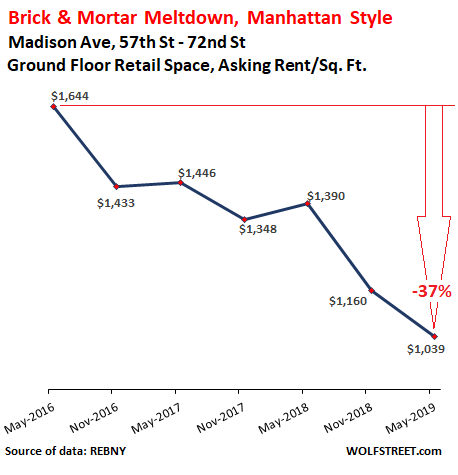
With these slashed asking rents along with concessions, such as buildouts and flexible lease terms, landlords are now trying to attract tenants for their vacant retail spaces that are now densely dotting the major shopping corridors in Manhattan. The entire report is focused on ground-floor retail spaces.
Out of the 17 shopping corridors in Manhattan that REBNY tracks, rents fell in 12 of them. Rents on Madison Avenue showed the steepest year-over-year decline. But in terms of the three-year window going back to May 2016, rents in other corridors fell even further.
The principle is this: Brick and mortar retail – outside of gas stations, grocery stores, and auto dealers, accounting for about half of total retail sales – is under heavy pressure from online competition. The last thing these under-pressure retailers can handle is sky-high rents.
This is an issue in other expensive cities as well, such as San Francisco, where shuttered and vacant retail shops are everywhere. What happens is that after a 10-year commercial lease expires, the landlord doubles the rent, and the retailer or restaurant, knowing the revenues the business generates, says, forget it and leaves. And then the shop sits vacant. This happens time after time.
The way forward: slashing rents to where businesses can make the numbers work out. And this is now happening in Manhattan. Concerning the Madison Ave corridor, REBNY says:
High availability rates along the corridor have led owners to continue lowering their rents and offer more short-term lease agreements. Flagship retailers across the prestigious strip are taking advantage of the softening rents by either locking in long-term lease agreements, moving to smaller-sized spaces, or migrating further south.
And just when America’s brick-and-mortar shopping tradition is under relentless and brutal attack from e-commerce, more retail availability is being created, with immaculate timing. REBNY:
Manhattan retail inventory increased with new high-profile development projects such as Hudson Yards, Gansevoort Row, the Seaport District, and Essex Crossing, which all offer competitive asking rents and elevated visibility.
Amid these new, prominent retail availabilities, property owners are facing pressure to reprice existing vacant retail spaces at lower asking rents. As a result, many owners are also offering greater flexibility to prospective tenants in the form of shorter-term deals, concessions, and build-outs.
So here are more samples of the 17 shopping corridors that REBNY tracks in its bi-annual Manhattan Retail Report, showing average asking rents for available ground-floor retail spaces:
Fifth Avenue, between 42nd and 49th Streets
The average asking rent fell 20% over the 12-month period, the third year in a row of declines, to $878 per square foot (psf). Compared to spring 2016, over the three years, the average asking rent has plunged 36%:
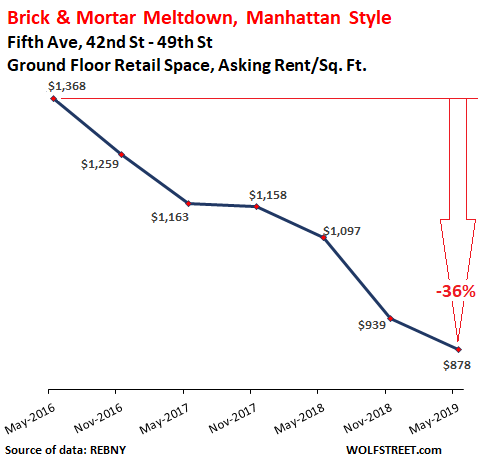
Fifth Avenue, between 49th and 59th Streets:
This is the most expensive corridor in Manhattan, in terms retail rents. The peak occurred in late 2017 and early 2018. Since then, the average asking rent has fallen 22%, to $3,047 psf. So that’s a decline of $853 psf:
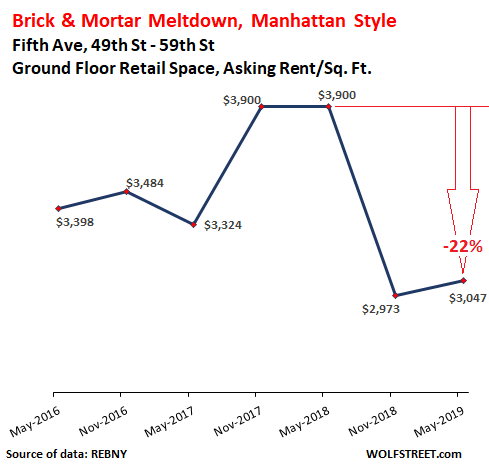
By comparison, this corridor is over 10 times more expensive than the corridor on 14th Street between 9th and 10th Ave and over 20 times more expensive than major corridors in Harlem. We’ll get to those in a moment. But when something is this impossibly high priced, is has the furthest to fall:
This decline is attributed to both historically high availability rates and low absorption rates, as high asking rents are diminishing tenant demand. Despite instances of rent reductions, newer owners who purchased spaces at peak market rates are slow to adjust their prices and are struggling to fill vacant spaces.
Bleecker Street, between 7th Ave South and Hudson St:
In this corridor in the West Village, the average asking rent has collapsed by 43% over the three years since 2016, to $294 psf.
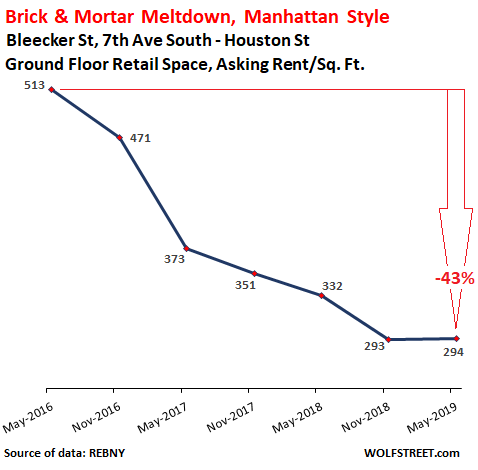
East 86th Street, between Lexington Ave and Second Ave:
The average asking rents fell 9% year-over-year to $365 psf, “due to more expensive retail spaces along Lexington Avenue being recently leased out by Old Navy and JP Morgan Chase with remaining availabilities along the corridor being located further eastwards where rents tend to be lower,” the report said:
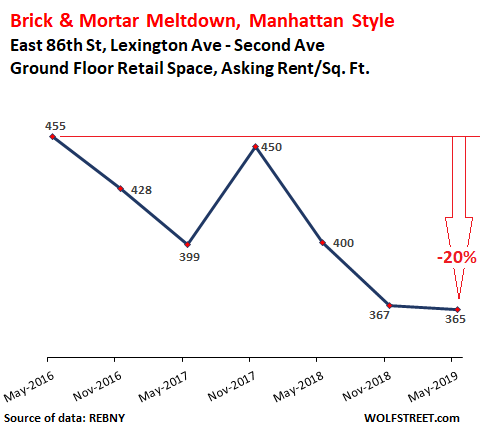
125th Street, between 5th Ave and Morningside Ave:
In this Harlem corridor, the average asking rent jumped 10% year-over-year to $137 psf, “attributed to several new spaces west of Fifth Avenue that came to market at the end of 2018, where rents tend to be higher compared to the east side. Deal-making along the corridor has remained steady with new tenants including Shake Shack, Whole Foods Market, Victoria’s Secret, and Bath & Body Works.” The average asking rent remains down a smidgen from 2016:
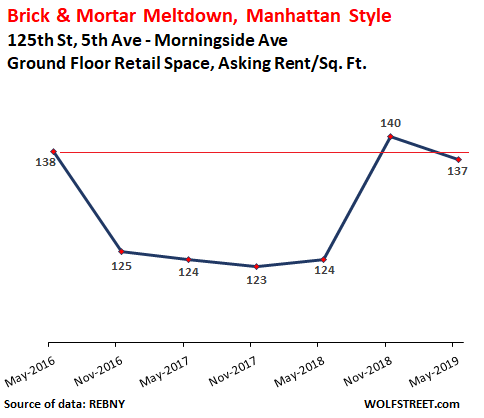
Columbus Avenue, between 66th and 79th Streets:
The average asking rent dropped 8% year-over-year to $279 psf, the third year in a row of declines. Over the three-year period, the asking rent has plunged 31%. REBNY says that the “price corrections” have actually “been ongoing since 2015”:
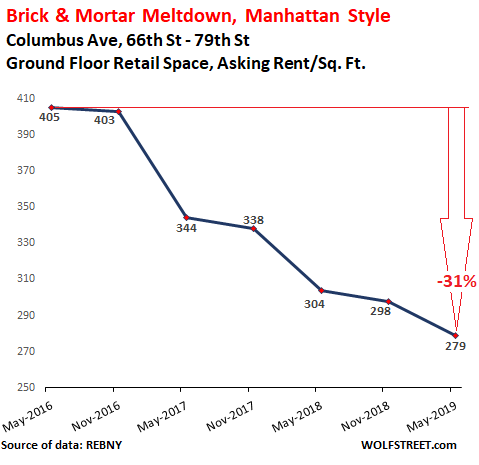
Broadway, Battery Park to Chambers Street
This corridor cuts through the Financial District, crosses Wall Street, and goes up to City Hall. It has undergone a huge change in recent years with major redevelopments all around, including numerous large residential developments in what used to be an area dominated by offices. Perhaps it was an outlier: The average rent jumped 19% in the six months from November to May, after it had dropped in the prior 12 months:
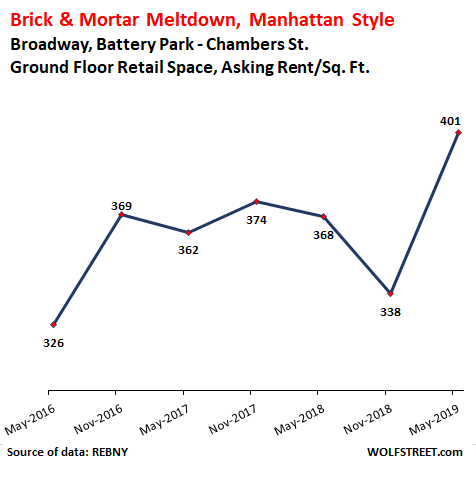
14th St, between 9th Ave and 10th Ave:
In this shopping corridor in the Meatpacking District, average asking rent dropped 12% year-over-year to $277 psf. Says REBNY:
Tourists, daytime workers, and nearby residents flock to the corridor for attractions such as The High Line, Google’s corporate campus, Chelsea Market, and Gansevoort Row. With this high foot traffic, 14th Street is viewed as the prime location for “experiential retail” concepts that cater to customer experiences, pop-up shops, fashion, and food and beverage stores.
Nevertheless, despite Google and all this enthusiasm about “experiential retail” concepts and what not, the average asking rent has dropped 20% over the past three years:
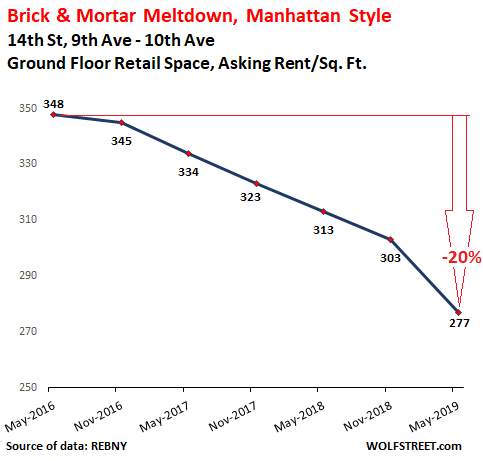
“Manhattan’s continued natural correction in retail rents is spurring deal-making across the borough’s top corridors as retailers reconsider new and existing ground floor spaces,” said REBNY President John Banks in the press release.
Price can fix a lot of problems. And there is always the other side – the very crucial other side: “Declining rents have fostered a healthier environment as more retail space is being absorbed at an affordable rate,” the report said. Because the easiest way to wipe out a majority of retailers on a street and then gaze at shuttered and vacant stores is to get greedy and try to obtain rents that the business cannot bear. At least a partial fix is to slash rents – and that’s finally happening.